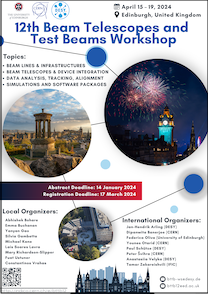Speaker
Description
The DESY II Test Beam facility offers electron beams with a user selectable momentum from 1-6 GeV, typically used for detector and sensor characterisation. The facility offers beam telescopes as precise reference tracking systems. These provide a very high spatial resolution. However, their readout time is long relative to the rate of incident electrons. This frequently results in more than one electron crossing the system within a single readout frame. Without an additional segmented timing layer, it becomes impossible to assign tracks to specific triggers.
Devices Under Test (DUTs) of varying sizes are characterised at the DESY II Test Beam facility. A size discrepancy between the trigger and the DUT leads to inefficient data taking by recording events where the electron has not intersected the DUT. To overcome this, a configurable region of interest trigger is needed.
TelePix2 is a High Voltage Monolithic Active Pixel Sensor (HV-MAPS); it provides both fast timing with a timestamp of 4 ns and a fast trigger output with a configurable region of interest. Here, characterisation results of TelePix2 are presented based on the latest test beam measurements. A time resolution for the timestamp below 5 ns was found across the full sensor at an efficiency above 99%. The time resolution of the trigger output from TelePix is below 2 ns. With these positive characterisation results and first successful runs with test users, TelePix2 is close to becoming part of the regular user infrastructure at the DESY test beam facility.
